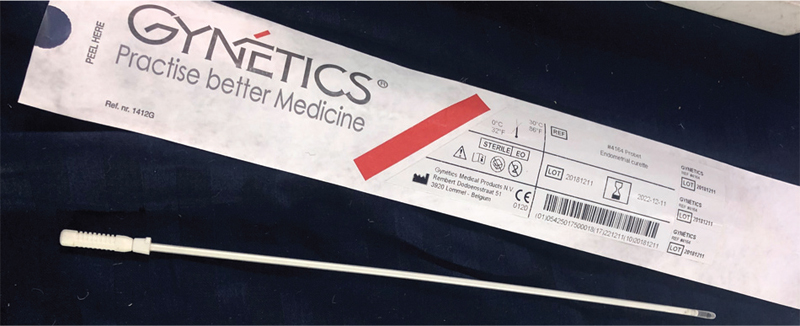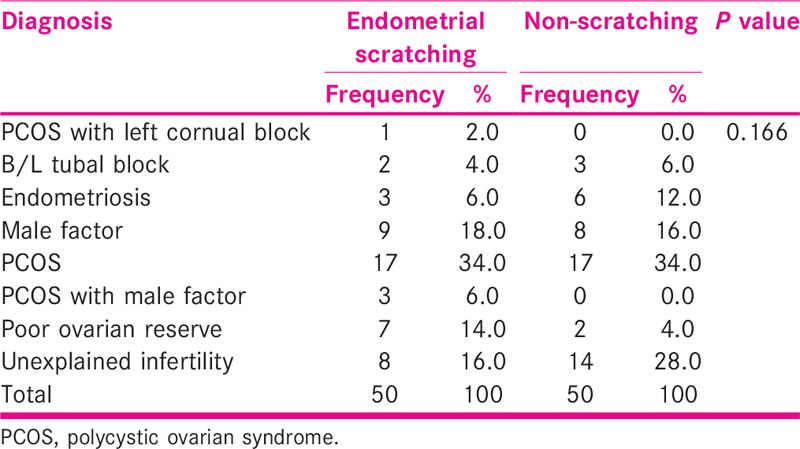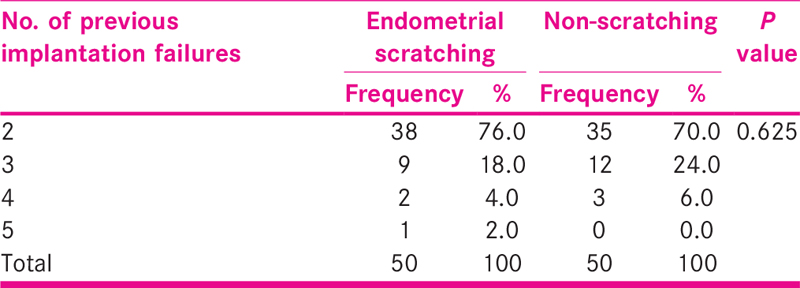Translate this page into:
Role of endometrial scratching among recurrent implantation failure patients undergoing in vitro fertilisation/ICSI
-
Received: ,
Accepted: ,
This is an open access journal, and articles are distributed under the terms of the Creative Commons Attribution-NonCommercial-ShareAlike 4.0 License, which allows others to remix, tweak, and build upon the work non-commercially, as long as appropriate credit is given and the new creations are licensed under the identical terms.
This article was originally published by Wolters Kluwer - Medknow and was migrated to Scientific Scholar after the change of Publisher.
Abstract
Aim and Objectives:
This article assesses the effect of endometrial scratching on improving rate of implantation in recurrent implantation failure patients and evaluates the potential and safety of endometrial scratching performed once before embryo transfer in women undergoing in vitro fertilisation.
Study Design:
This was a prospective interventional study.
Study Period:
This study was conducted from August 2018 to March 2019.
Study Setting:
Fertility Research Centre.
Material and Methods:
In this randomised control trial study, 100 patients each with at least two implantation failures were randomly assigned into two groups. In the case group (50 patients), endometrial scratching was performed in mid-luteal phase of the cycle prior to controlled ovarian hyperstimulation with disposable pipelle catheter and embryo transfer (day 3) performed in the next cycle. Clinical pregnancy and implantation rates were compared thereafter.
Statistical Analysis:
Data were analysed using Social Science System (SPSS) version 17.0 using appropriate statistical tests.
Results:
Clinical pregnancy was 38% in the scratching group and 30% in the non-scratching group while implantation rate was 15.8% and 11.5% in scratching and non-scratching group, respectively.
Conclusion:
Endometrial scratching was found to be very safe and a cost-effective technique in women undergoing in vitro fertilisation, and when it was performed in the mid-luteal phase of the previous cycle, it showed increase in chance of clinical pregnancy and implantation rate to some extent. However, as this study was performed on a smaller group, its reliability in clinical practice needs further research by randomised control trials on a larger study group.
Keywords
Endometrial scratch
implantation failure
in vitro fertilisation
pipelle
INTRODUCTION
One of the major cause of repeated in vitro fertilisation (IVF)/intracytoplasmic sperm injection (ICSI) failure is related to failure of implantation.[1,2,3,4] Implantation is defined as the attachment of good quality embryo or blastocyst to receptive endometrium in the window of implantation, which is during a specific period.[5] Many reports suggested that scratching of endometrium with a pipelle catheter resulted in improved rate of implantation in next cycle.[1,2,3,4] The current study was conducted with the aim to assess the effect of endometrial scratching to improve rate of implantation in repeated implantation failure patients and to evaluate the efficacy and safety of endometrial scratching when performed prior to embryo transfer in IVF patients.
MATERIALS AND METHODS
This prospective interventional study was conducted at the Department of Assisted Reproductive Technology of a fertility research center.
In this randomised control trial study, 100 patients each with at least two implantation failures were randomly assigned equally into two groups. In the case group, endometrial scratching was performed in mid-luteal phase of the cycle prior to controlled ovarian hyperstimulation with disposable pipelle catheter (Gynetics Medical Products N.V., Rembert Dodoensstraat, Lommel, Belgium) [Figure 1] and embryo transfer (day 3) performed in the next cycle. Implantation and clinical pregnancy rates were compared thereafter among patients in the non-interventional group.

- Pipelle catheter (GYNETICS).
The present study was conducted among the patients attending the fertility center after fulfilling the following inclusion and exclusion criteria.
Inclusion criteria
Women between 18 and 44 years of age with primary or secondary fertility failure and normal transvaginal ultrasound (3DVS).
Women with previous two or more implantation failures.
Exclusion criteria
History of acute or chronic lower abdominal and/or pelvic infections.
Untreated unilateral or bilateral hydrosalpinx.
History of endometrial scratching in previous IVF cycles.
Untreated endometrial tuberculosis.
Medical contraindications of IVF/ICSI.
Study procedure
The patient was placed in lithotomy position. No anaesthesia or analgesics were given prior to the procedure. Under all aseptic precautions, a Sims speculum (Golden Star Surgical Industries, Jalandhar, Punjab) was inserted in the vagina to retract the posterior vaginal wall and the anterior lip of cervix was held with Allis forceps. A flexible plastic sterile pipelle catheter (3 mm wide) was introduced through the cervix gently into the uterine cavity and advanced slowly till just resistant felt, where it was moved back and forth and rotated within the uterus (360°) a few times to cause local injury and some disruption to the endometrial lining. The pipelle catheter and vaginal speculum was removed gently followed by vaginal toileting with betadine. Post-procedural complains were noted and patients were counselled regarding the same.
RESULTS
Table 1 shows the comparison of mean age between the two groups. It was observed that the mean age scratching group was 30.04 ± 4.41 years whereas mean age of non-scratching group was 29.40 ± 4.15 years. Further, it was observed that the difference in mean age between the two groups was not significant (P value of 0.457).

As per Table 2, maximum patients were of primary infertility in both the groups (Group A: 72%; Group B: 78%). Patients with secondary infertility in Group A were 28% and in Group B were 22%. No significant statistical difference was seen in the type of infertility between the two groups (P value of 0.488).

Table 3 shows that mean duration of infertility was almost similar in both the groups (P value 0.873).

As per Table 4, maximum number of patients were suffering from polycystic ovarian Syndrome (PCOS), followed by unexplained infertility and male factor infertility in both the groups. But there was no significant statistical difference in both the groups regarding the cause of infertility (P value 0.166).

In Table 5, maximum number of patients were with two implantation failures in both the groups (Group A: 76%; Group B: 70%).

Only 10% of patients had mild complaints post scratching [minimal per vaginal (PV) spotting, mild discomfort and mild lower abdominal pain] [Table 6].

According to Table 7, there was no significant difference observedno in mean endometrial thickness of patients in the study as well as the control group (P value 0.657).

In both the groups, three embryos were transferred in majority of patients (Group A: 66%; Group B: 62%) [Table 8].

Although biochemical pregnancy rate in endometrial scratching group and non-scratching group was 38% and 34%, respectively, it was statistically insignificant (P value 0.677) [Table 9].

According to Table 10, higher rates of clinical pregnancy was seen in endometrial scratching group (38%) compared to non-scratching group that was 30% as in group B (non-scratching); two biochemical pregnancies (4%) did not progress to clinical pregnancy.

The difference in clinical pregnancies in both the groups was statistically insignificant (P value 0.581).
Table 11 shows that implantation rate was more in endometrial scratching group (15.8%) compared to the non-endometrial scratching group (11.5%). The difference was statistically insignificant (P value 0.304).

In interventional group, singleton pregnancy was seen in 17 patients (34%) and twin pregnancy in two patients (4%). Similarly, in control group, singleton pregnancy was seen in 13 patients (26%) and twin pregnancy in just one patient (2%).
DISCUSSION
A lot of trials have been undertaken to establish the effect of endometrial scratching in patients undergoing IVF/ICSI cycles, but the significant variation remains in scratching technique, the type of patients chosen for scratching and the reliability of study. Due to these variations, the actual group of patient who can be benefitted by this method is still not confirmed.
Although this subgroup is well enumerated in literature, many parameters like different fertility treatments prior to IVF and different number of embryos transferred are still diverse. Generally, ‘implantation failure’ is a term in context with females who have at least failed thrice to implant good quality embryos which shifts the basis of this study to paramount the efficacy of assisted reproductive technology at early stages with utmost consideration to patient’s safety and comfort.
In the present study, endometrial scratching performed in the mid-luteal phase of previous cycle showed increase in chance of clinical pregnancy and implantation rate to some extent. Clinical pregnancy was 38% in the scratching group and 30% in the non-scratching group whereas implantation rate was 15.8% and 11.5% in the scratching and non-scratching group, respectively.
There has been a positive response in rate of clinical pregnancy and live births according to multiple previous trials.[6,7,8,9,10,11,12] The initial demonstration of beneficial effect of endometrial scratching was done by Barash et al.[6] which showed almost doubling of the rates of implantation, clinical pregnancy and live births in recurrent implantation failure patients.[7] A study has shown its negative impact on clinical pregnancy when done at oocyte pickup time and not at the cycle preceding embryo transfer.[13] Some studies have concluded endometrial scratching to be of no significant benefit.[14,15,16] A study performed by Yeung et al.[16] demonstrated endometrial scratching to be of no benefit in increasing chances of pregnancy when it was done in luteal phase of previous cycle rate.[13]
The illustrated notable advantages of endometrial trauma in patients with repeated implantation failures has brought its existence into an interesting procedure which can be used in all patients prior to IVF treatments.
Suggestions have been made stating that nidation and pregnancy outcomes may be dependent on the timing and frequency of endometrial scratching performed and also on the extent of scratching done. The authors also suggested that endometrial scratching done on oocyte pickup day in same embryo transfer (ET) cycle had detrimental impact on pregnancy outcomes.[13] Our study was based on endometrial scratching performed once in mid-luteal phase prior to IVF/ICSI cycle. However, the fact regarding ideal timing and number of times endometrial scratching required is not yet established. We selected the ‘window of nidation’ which is supposed to have maximum expression of cytokines, growth factors and other immune mediators in endometrium and thus the utmost impact of endometrial trauma is expected in this period.[17]In the latest rational, multicenter, randomised controlled trial on endometrial scratching done on total of 1364 women, there was no difference in live birth rates after endometrial trauma when compared to control group.[18] Live birth rate was 26.1% (180 out of 690 females) in test group and same 26.1% in the control group (176 out of 674 females).
Generally, endometrial scratching is being carried out as as an OPD procedure. Although, there are negative prospects which are based on previous studies stating that this intervention when performed on oocyte pickup day had led to decreased rates of implantation as well as pregnancy.[18] However, it has not shown any detrimental effects when performed in cycle previous to IVF/ICSI, except for mild discomfort and mild lower abdominal pain. No other significant complains were observed in our study. Routine analgesics can be given prior to the procedure to reduce this. There is a potential risk for intrauterine infection while performing any intrauterine procedure. We know that patients with any type of vaginal or known pelvic infections are usually screened and treated before the commencement of IVF/ICSI cycle, thus minimizing the chances of any further spread of these infections during embryo transfer.
CONCLUSION
Endometrial scratching is very safe and cost effective outpatient procedure. It can also be done during diagnostic hysteroscopy.
Endometrial scratching performed once before IVF-ET increased the chance of clinical pregnancy and implantation rate to some extent; but as the study was performed on a smaller group, its reliability in clinical practice needs further research by randomised control trials on a larger study group.
Although reassurance of patients was done regarding post-procedural mild discomfort and PV spotting, in our study, none of the patients complained of any post-procedural infection, persistent bleeding or significant pain in lower abdomen.
Financial support and sponsorship
Nil.
Conflicts of interest
There are no conflicts of interest.
REFERENCES
- Local injury to the endometrium: its effect on implantation. Curr Opin Obstet Gynecol. 2009;21:236-9.
- [Google Scholar]
- Advanced endometrial maturation after ovulation induction with human menopausal gonadotropin/human chorionic gonado tropin for in vitro fertilization. Fertil Steril. 1984;41:31-5.
- [Google Scholar]
- The luteal phase of cycles utilizing controlled ovarian hyperstimulation and the possible impact of this hyperstimulation on embryo implantation. Am J Obstet Gynecol. 1997;176:1262-7.
- [Google Scholar]
- Impact of ovarian hyperstimulation on the luteal phase. J Reprod Fertil Suppl. 2000;55:101-8.
- [Google Scholar]
- Defective endometrial prostaglandin synthesis identified in patients with repeated implantation failure undergoing in vitro fertilization. Fertil Steril. 2010;94:1271-8.
- [Google Scholar]
- Local injury to the endometrium doubles the incidence of successful pregnancies in patients undergoing in vitro fertilization. Fertil Steril. 2003;79:1317-22.
- [Google Scholar]
- Endometrial injury to overcome recurrent embryo implantation failure: a systematic review and meta-analysis. Reprod Biomed Online. 2012;25:561-71.
- [Google Scholar]
- Favorable influence of local injury to the endometrium in intracytoplasmic sperm injection patients with high-order implantation failure. Fertil Steril. 2007;87:198-201.
- [Google Scholar]
- Local endometrial injury and IVF outcome: a systematic review and meta-analysis. Reprod Biomed Online. 2012;25:345-54.
- [Google Scholar]
- Endometrial injury in women undergoing assisted reproductive techniques. Cochrane Database Syst Rev (3):CD009517.
- [Google Scholar]
- Impact on IVF outcome following pre-IVF hysteroscopy and endometrial scratching. Austin J Reprod Med Infertil. 2015;2:1029.
- [Google Scholar]
- Therapeutic efficacy of endometrial scratching in repeated controlled ovarian stimulation (COS) failure cycles. J Hum Reprod Sci. 2018;11:59-71.
- [Google Scholar]
- Local injury to the endometrium on the day of oocyte retrieval has a negative impact on implantation in assisted reproductive cycles: a randomized controlled trial. Arch Gynecol Obstet. 2010;281:499-503.
- [Google Scholar]
- Does local injury to the endometrium before IVF cycle really affect treatment outcome? Results of a randomized placebo controlled trial. Gynecol Endocrinol. 2012;28:933-6.
- [Google Scholar]
- Effect of local endometrial injury on pregnancy outcomes in ovum donation cycles. Fertil Steril. 2014;102:1048-54.
- [Google Scholar]
- The effect of endometrial injury on ongoing pregnancy rate in unselected subfertile women undergoing in vitro fertilization: a randomized controlled trial. Hum Reprod. 2014;29:2474-81.
- [Google Scholar]
- Local injury of the endometrium induces an inflammatory response that promotes successful implantation. Fertil Steril. 2010;94:2030-6.
- [Google Scholar]
- A randomized trial of endometrial scratching before in vitro fertilization. N Engl J Med. 2019;380:325-34.
- [Google Scholar]







